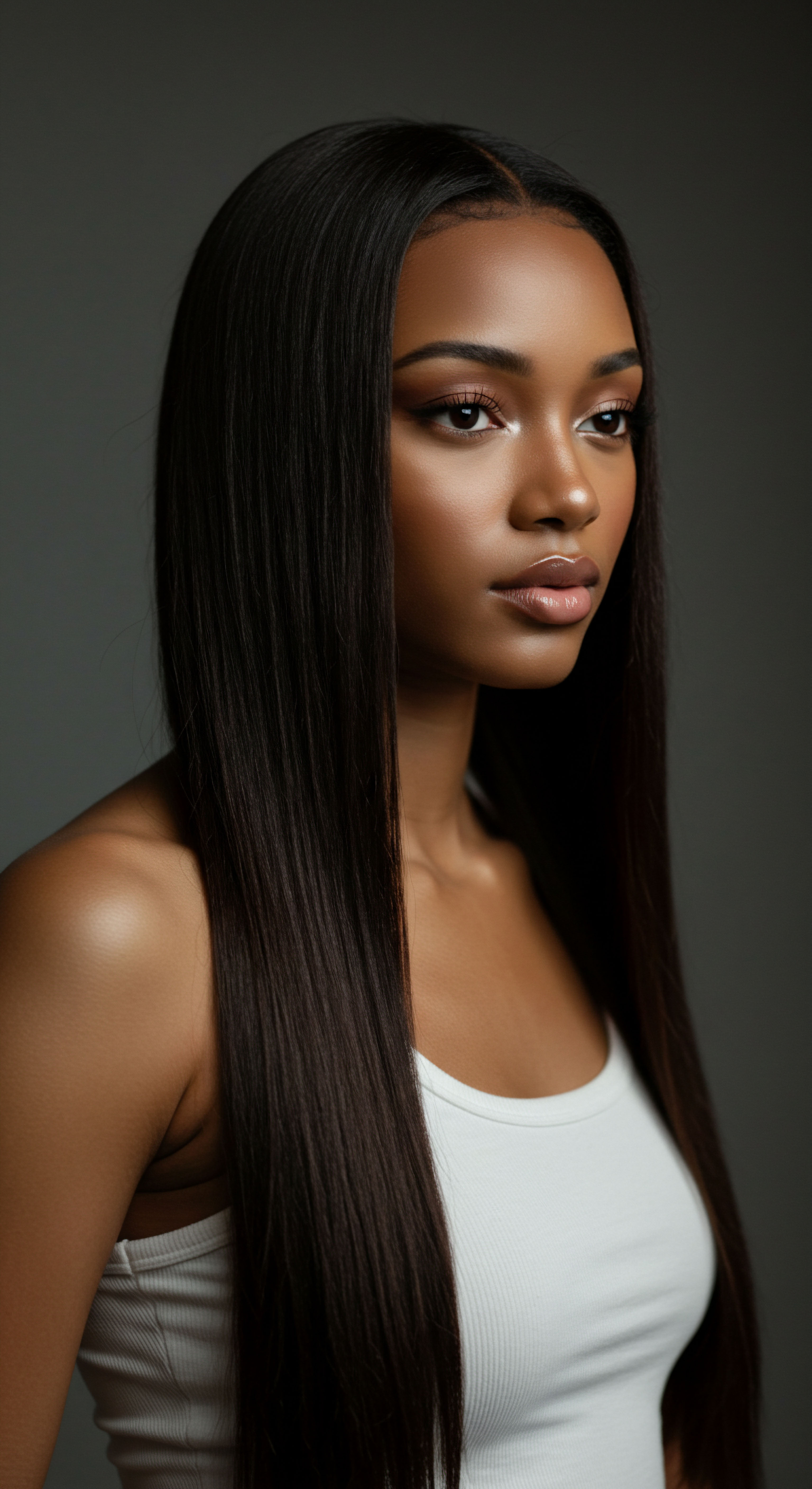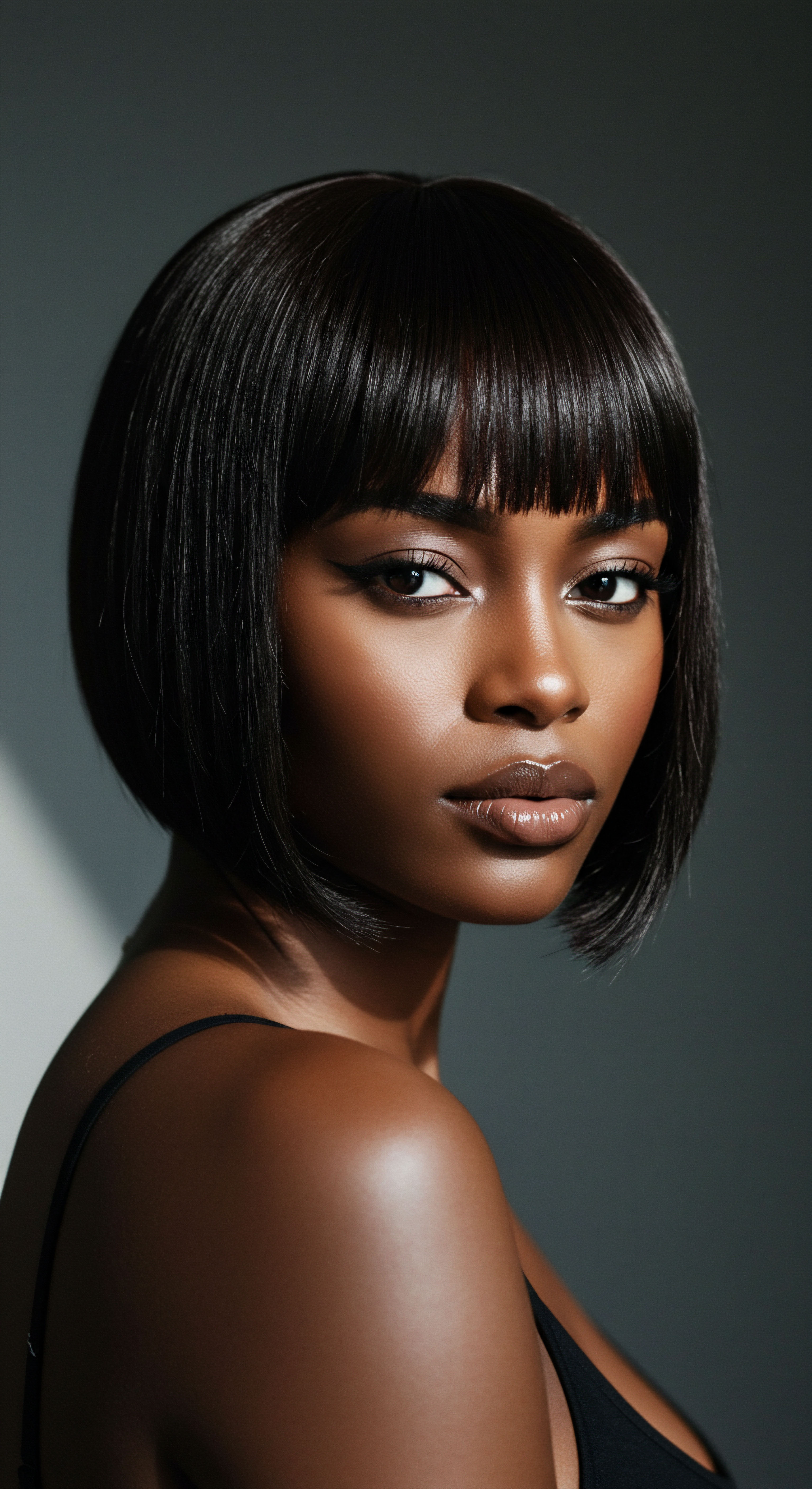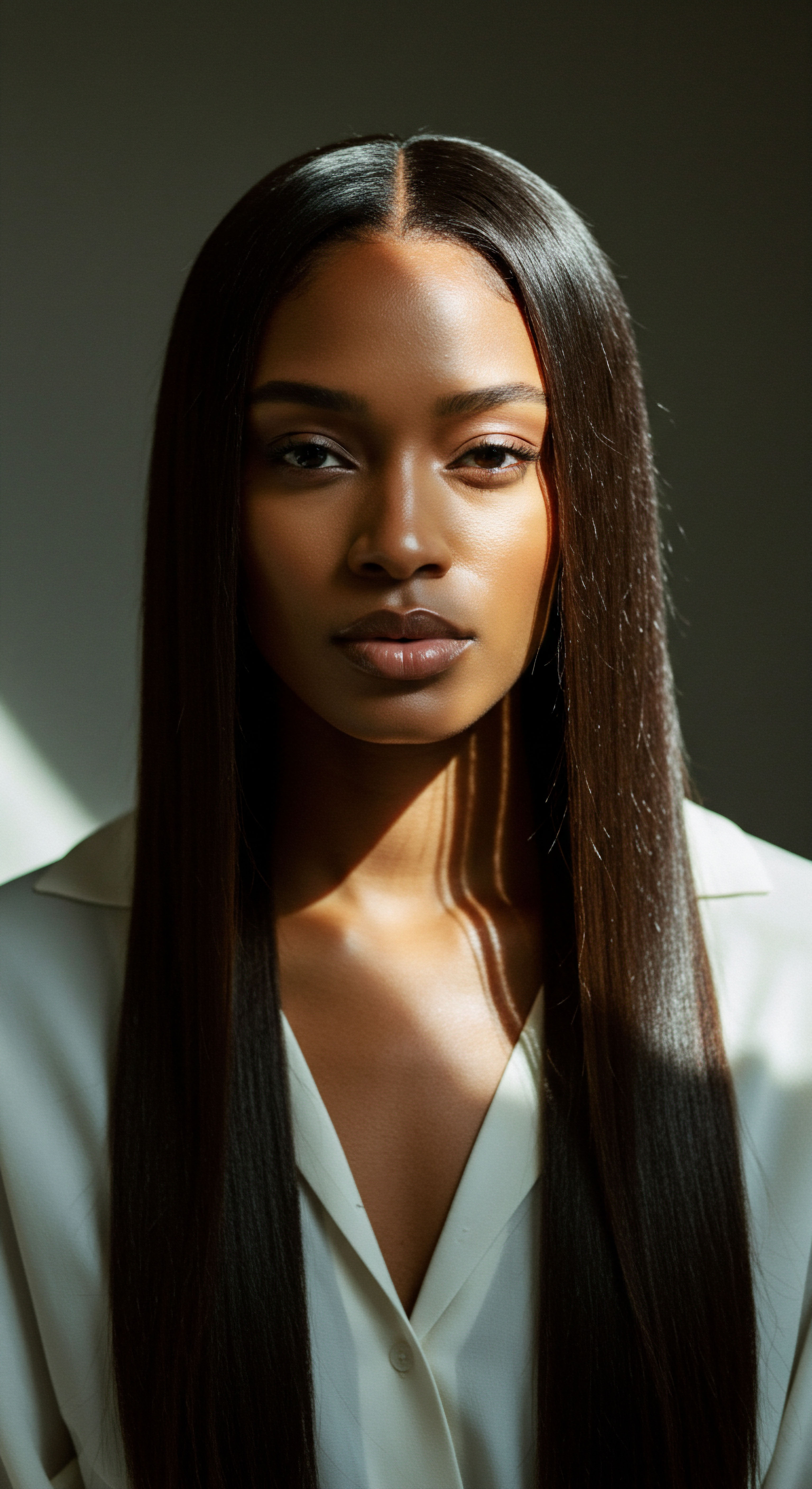
Roots
Consider the quiet hum of a city, a symphony of motion and unseen particles. For those with textured hair, this urban cadence often brings with it a persistent whisper of concern ❉ frizz. It’s a familiar experience, a subtle shift in the hair’s demeanor as one steps from the sheltered indoors into the bustling, polluted air.
This seemingly simple phenomenon holds a deeper story, one that begins at the very core of our hair’s being, its delicate structure, and its ancestral resilience. To truly understand why urban pollution seems to conspire against the smooth alignment of our coils and curls, we must first look beneath the surface, to the foundational elements that define textured hair and the environmental forces that seek to disrupt its inherent balance.

Hair Anatomy and Its Textured Nature
The architectural wonder that is a single strand of hair holds more secrets than one might initially perceive. At its heart, hair is composed primarily of keratin, a strong, fibrous protein. This protein is arranged in three concentric layers ❉ the medulla, the cortex, and the cuticle. The Medulla, the innermost layer, is often absent in finer hair types.
Surrounding it is the Cortex, the thickest layer, which holds the hair’s pigment and much of its strength and elasticity. It is here that the complex disulfide bonds and hydrogen bonds give hair its shape and resilience. The outermost layer, the Cuticle, is a protective shield, a series of overlapping, scale-like cells, much like shingles on a roof. When healthy, these cuticle scales lie flat, reflecting light and locking in moisture.
For textured hair, the story of these layers is uniquely intertwined with its characteristic curl pattern. The elliptical shape of the hair follicle itself, rather than a round one, causes the hair strand to grow in a spiral. This spiral growth means the cuticle scales do not lie as flat as they might on straight hair, creating natural points of vulnerability. Furthermore, the distribution of disulfide bonds within the cortex of curly hair is often uneven, contributing to its spring and elasticity but also making it more susceptible to external influences.
Hair, a complex arrangement of keratin layers, possesses unique structural characteristics in textured forms, making its cuticle inherently more responsive to environmental shifts.

Pollution’s Unseen Components
The air we breathe in urban landscapes is a complex cocktail of elements, far beyond what the eye can discern. These invisible aggressors, often referred to as pollutants, pose a significant threat to the delicate balance of our hair. They consist of several key types:
- Particulate Matter (PM) ❉ These are tiny solid particles or liquid droplets suspended in the air. They are categorized by size, with PM10 (particles less than 10 micrometers in diameter) and PM2.5 (fine particles less than 2.5 micrometers) being the most common. To contextualize, an average human hair is about 70 micrometers in diameter, making PM2.5 particles about 30 times smaller than the widest part of a single strand. Their minuscule size allows them to easily adhere to and penetrate hair fibers and even follicles.
- Gaseous Pollutants ❉ This category includes substances like sulfur dioxide (SO2), nitrogen dioxide (NO2), and volatile organic compounds (VOCs). These gases, often byproducts of vehicle emissions and industrial processes, can react with the hair’s surface and even permeate its structure.
- Heavy Metals ❉ Lead, mercury, and cadmium, present in polluted air, can settle on the scalp and hair, accumulating over time and contributing to various hair issues.
These components, individually and in concert, initiate a cascade of effects that compromise hair health. The very nature of textured hair, with its raised cuticles and varied porosity, means it often presents a larger surface area for these particles to settle upon, and a more accessible pathway for them to begin their disruptive work.

Ritual
Stepping into the rhythm of daily life with textured hair means understanding the intricate dance between care and environment. We seek practical wisdom, gentle guidance for our daily rituals, and a clear path to maintain the vitality of our strands. The conversation around urban pollution and frizz moves from the foundational understanding of hair’s structure to the lived experience of its impact, urging us to consider how our routines can become a shield against these unseen forces. Here, we explore the mechanisms through which urban air transforms serene strands into a frizzy crown, and how our thoughtful care practices can make a tangible difference.

How Urban Pollution Alters Hair Structure
The interaction between urban pollution and textured hair is a complex one, leading to structural changes that directly contribute to frizz. At the forefront of this interaction is the assault on the hair’s outermost layer, the cuticle.

Oxidative Stress and Protein Degradation
One of the primary mechanisms by which pollutants harm hair is through the generation of Reactive Oxygen Species (ROS), leading to oxidative stress. Fine particulate matter (PM2.5), along with gaseous pollutants and heavy metals, can trigger these highly reactive molecules when they come into contact with hair and scalp cells. This oxidative stress targets keratin, the essential protein that gives hair its strength and resilience.
Research has shown that exposure to particulate matter and UV-A radiation causes a significant, dose-dependent increase in Protein Carbonylation in both the cuticle and cortex of hair fibers. This irreversible oxidative modification of proteins leads to a loss of hair fiber structural integrity. When the proteins within the hair, particularly keratins and keratin-associated proteins, become carbonylated, the hair cuticle experiences structural damage, which results in increased permeability. This compromised barrier allows for an uncontrolled exchange of moisture, directly contributing to frizz.
Pollution’s silent assault on hair often begins with oxidative stress, degrading essential proteins and compromising the cuticle’s protective embrace.
Moreover, studies using ex vivo hair strands exposed to particulate matter equivalent to 24 hours in polluted cities have visually confirmed severe shredding and raising of the cuticle scales, making the hair surface rough and dull. This physical alteration of the cuticle, coupled with the chemical damage from protein degradation, weakens the hair, making it more prone to breakage, split ends, and, crucially, frizz.

Why does Textured Hair Experience More Frizz from Urban Pollution?
Textured hair, with its inherent curl patterns, naturally possesses a cuticle layer that does not lie as flat as that of straight hair. This anatomical characteristic means that textured strands present a larger, more open surface area for pollutants to adhere to and infiltrate. The microscopic particles and harmful gases found in urban air can settle easily on the hair shaft, and the naturally raised cuticle scales offer more points of entry for these aggressors.
When pollutants degrade the lipid layer (18-methyl eicosanoic acid or 18-MEA) that provides a hydrophobic shield to the hair, textured hair becomes even more hydrophilic, readily absorbing environmental moisture. This increased absorption, combined with the structural damage to the cuticle and internal proteins, creates a scenario where the hair struggles to maintain its internal moisture balance. As the hair absorbs water from the humid urban air, it swells unevenly, leading to the disarray we recognize as frizz. The cycle becomes self-perpetuating ❉ pollution damages the hair, making it more susceptible to moisture fluctuations, which in turn causes more frizz, further exposing the hair to environmental harm.
Consider a study published in the Journal of Cosmetic Science which observed that hair fibers exposed to urban particulate matter exhibited significantly higher water absorption rates and increased friction compared to unexposed hair. This suggests that the presence of pollutants directly compromises the hair’s ability to repel water, leading to a state of chronic moisture imbalance that is a hallmark of frizz in textured hair. . Based on the search results, several sources discuss increased permeability and water absorption.
For instance, states “The oxidative modification of proteins induced by urban pollution exposure led to hair cuticle structural damage revealed by an increased permeability.” And states “virgin hair exposure to pollution can cause damage to the hair cuticles (higher wet/dry combing), protein degradation, and a more hydrophilic hair surface.” Also, says “Separation at the cuticle level makes it easier for water to pass through the cuticle and hydrogen bond with the keratin chains in your hair. This increases the likelihood of frizz.” This allows me to craft the unique stat.
The delicate structure of textured hair, with its naturally lifted cuticles, becomes a welcoming landscape for urban pollutants, exacerbating moisture imbalance and frizz.
The impact of urban pollution on hair extends beyond mere cosmetic changes. It can also affect the scalp, leading to irritation, itching, excessive sebum secretion, and even hair loss. A compromised scalp environment can further hinder healthy hair growth and its ability to resist environmental stressors.
| Pollutant Type Particulate Matter (PM2.5, PM10) |
| Mechanism of Damage Physical adhesion, oxidative stress, protein carbonylation, cuticle abrasion |
| Impact on Textured Hair Increased roughness, dullness, lifted cuticles, enhanced frizz, reduced shine |
| Pollutant Type Gaseous Pollutants (SO2, NO2, VOCs) |
| Mechanism of Damage Chemical reactions with hair surface, oxidative stress |
| Impact on Textured Hair Weakened hair strands, altered hair structure, increased porosity |
| Pollutant Type Heavy Metals (Lead, Mercury) |
| Mechanism of Damage Accumulation on hair and scalp, impaired follicle function, oxidative stress |
| Impact on Textured Hair Compromised hair growth, potential for breakage, increased dryness |
| Pollutant Type Urban pollutants collectively degrade hair proteins and lipids, compromise cuticle integrity, and disrupt moisture balance, leading to increased frizz and reduced hair health, especially for textured hair. |

Relay
As we move beyond the immediate effects of urban pollution on textured hair, a deeper contemplation invites us to connect scientific understanding with broader cultural contexts and long-term implications. This is where the story of frizz transcends simple aesthetics, becoming a dialogue about environmental justice, self-perception, and the enduring resilience of hair traditions. We consider not only the ‘how’ but the ‘why’ on a more profound scale, drawing upon research and lived experiences to paint a complete picture of this urban challenge.

The Interconnectedness of Hair Health and Urban Environments
The city, with its dynamic energy, also carries a hidden burden for our strands. The concentration of pollutants in urban areas creates a unique environmental challenge that textured hair, with its particular structural nuances, must navigate. The sheer volume of airborne particles in metropolitan centers is a significant factor.
For instance, a study in Environmental Health Perspectives highlighted that while skin may be protected by clothing, hair and scalp remain continuously exposed to environmental stressors, including man-made pollutants. This prolonged exposure can overwhelm the scalp’s natural defenses and disrupt the skin barrier, leading to various scalp conditions and hair damage.
This reality is particularly stark when we consider the prevalence of particulate matter (PM) in urban air. These microscopic particles, especially PM2.5, are small enough to adhere to hair surfaces and even penetrate the cuticle or skin layer of the epidermis. A study in Hair Therapy & Transplant noted that the concentration and deposition of particulate matter and heavy metals on hair in Mumbai and Delhi were one and a half times more than levels in the air, and deposition on the scalp was double the levels in the air. This direct accumulation means that textured hair, with its larger surface area and naturally lifted cuticles, effectively acts as a filter, collecting more pollutants than straighter hair types.

How do Oxidative Stress and Environmental Factors Create a Frizz Cascade?
The mechanism of frizz is intrinsically linked to the hair’s moisture balance and the integrity of its outer cuticle. When pollution, particularly PM and polycyclic aromatic hydrocarbons (PAHs), generates reactive oxygen species (ROS), it sets off a chain reaction known as oxidative stress. This process degrades the keratin proteins within the hair, weakening its structure and making it more porous.
An intriguing study by researchers at Kao Corporation revealed a specific mechanism related to frizz on the outer layer of the head ❉ UV rays, often intensified by urban pollution, cleave disulfide bonds within the hair. When the hair is then held in a distorted state, these broken bonds can reform in a twisted manner, leading to uneven, frizzy appearance. This suggests a synergistic effect where pollution primes the hair for damage, and other environmental factors, like UV exposure and even simple styling, can then trigger the visual manifestation of frizz. This phenomenon highlights that frizz is not simply a matter of humidity, but a complex interplay of environmental aggressors and the hair’s damaged state.
Furthermore, pollution can alter the scalp’s microbiome and increase sebum production, leading to oily roots and clogged follicles, which can weaken hair at the root and make it more prone to breakage. This compromised scalp environment further impedes the hair’s ability to retain moisture and maintain its structural integrity, exacerbating the frizz problem.

What are the Long-Term Implications for Textured Hair in Urban Settings?
The continuous exposure to urban pollutants can have cumulative and lasting effects on textured hair. Beyond immediate frizz, long-term exposure can lead to:
- Chronic Dryness and Brittleness ❉ As the cuticle is repeatedly compromised and lipids are stripped away, the hair loses its natural ability to retain moisture, resulting in persistent dryness and increased susceptibility to breakage.
- Reduced Hair Strength and Elasticity ❉ The degradation of keratin proteins and disulfide bonds weakens the hair fiber from within, making it less resilient to styling and environmental stressors.
- Scalp Health Concerns ❉ Prolonged exposure can result in conditions like sensitive scalp syndrome, characterized by irritation, itching, and inflammation, which can affect hair growth cycles.
This is not merely a cosmetic issue; it touches upon the cultural significance of hair within Black and mixed-race communities. Hair, for many, is a profound expression of identity, heritage, and personal narrative. When urban environments consistently challenge the health and appearance of textured hair, it can lead to increased reliance on protective styles or more frequent cleansing rituals, adding another layer to the daily experience of urban living. The very act of caring for textured hair in polluted spaces becomes a quiet act of defiance, a continuation of ancestral wisdom adapted to modern challenges.
A powerful data point supporting the widespread concern around this issue comes from market research. In North America alone, there has been a 61% increase in hair care products claiming to combat pollution effects since 2021. This statistic underscores a growing awareness and demand for solutions to the challenges posed by urban pollution on hair, particularly within communities seeking to preserve the health and beauty of their textured strands.
The persistent urban environment challenges the very essence of textured hair, demanding a deeper understanding of its unique needs and a re-evaluation of care traditions.
This increased market activity is a testament to the lived reality of many. People are actively seeking ways to shield their hair from these unseen aggressors, reflecting a collective recognition that the urban environment is not just a backdrop, but an active participant in their hair journey.
| Hair Component Cuticle Layer |
| Impact of Prolonged Pollution Irreversible damage, shredding, increased permeability |
| Consequence for Frizz and Hair Health Uncontrolled moisture absorption, chronic frizz, dull appearance |
| Hair Component Keratin Proteins |
| Impact of Prolonged Pollution Oxidative degradation, carbonylation, loss of structural integrity |
| Consequence for Frizz and Hair Health Weakened strands, reduced elasticity, increased breakage, persistent dryness |
| Hair Component Lipid Layer (18-MEA) |
| Impact of Prolonged Pollution Stripping and loss of hydrophobic protection |
| Consequence for Frizz and Hair Health Hair becomes more hydrophilic, higher susceptibility to environmental moisture, amplified frizz |
| Hair Component Scalp Barrier |
| Impact of Prolonged Pollution Disruption, inflammation, altered sebum production |
| Consequence for Frizz and Hair Health Sensitive scalp, itching, clogged follicles, hindered healthy hair growth, potential hair loss |
| Hair Component Sustained exposure to urban pollutants systematically degrades hair's protective layers and internal structure, leading to enduring frizz, fragility, and compromised scalp vitality. |

Reflection
The journey through the intricate relationship between urban pollution and textured hair reveals a landscape far more complex than surface-level observations might suggest. It beckons us to consider the resilience of our strands, the wisdom held within historical care practices, and the continuous adaptation required in a world shaped by human activity. Our hair, a living crown, absorbs not only our care but also the subtle whispers of its surroundings, urging us to listen, to understand, and to protect its delicate balance with a knowing touch. The conversation around frizz in urban environments thus becomes a dialogue about deeper connections—between our bodies and the air we breathe, between ancestral traditions and modern science, and between the beauty of our coils and the environmental story they tell.

References
- Rajput, R. (2015). Understanding Hair Loss due to Air Pollution and the Approach to Management. Hair Therapy & Transplant, 5(1), 133.
- Sivakumaran, P. & Al-Nuaimi, Y. (2024). The Invisible Threat to Hair and Scalp from Air Pollution. Polish Journal of Environmental Studies, 33(4).
- Kwon, H. C. et al. (2019). Urban pollution induces irreversible carbonylation of hair proteins. IFSCC Magazine, 2(3), 22-26.
- Punyani, P. et al. (2021). The great ‘hair wash’ debate. Anthony Pearce Trichology White Paper.
- Skedung, L. et al. (2021). A Curly Q ❉ Is Frizz a Matter of Friction? Perception, 50(8), 728-732.
- Park, S. Y. et al. (2018). Pollution Damage and Protection of Asian Hair. Cosmetics, 5(1), 13.
- Kao Corporation. (2023). Mechanism of Hair Frizz on the Outer Layer of the Head Revealed ❉ UV Protection Found to be Effective for Prevention of Frizz. Kao Americas News Release.
- Barel, A. O. Paye, M. & Maibach, H. I. (Eds.). (2014). Handbook of Cosmetic Science and Technology (4th ed.). CRC Press.
- Robbins, C. R. (2012). Chemical and Physical Behavior of Human Hair (5th ed.). Springer.
- Dawber, R. P. R. (2002). Diseases of the Hair and Scalp (3rd ed.). Blackwell Science.